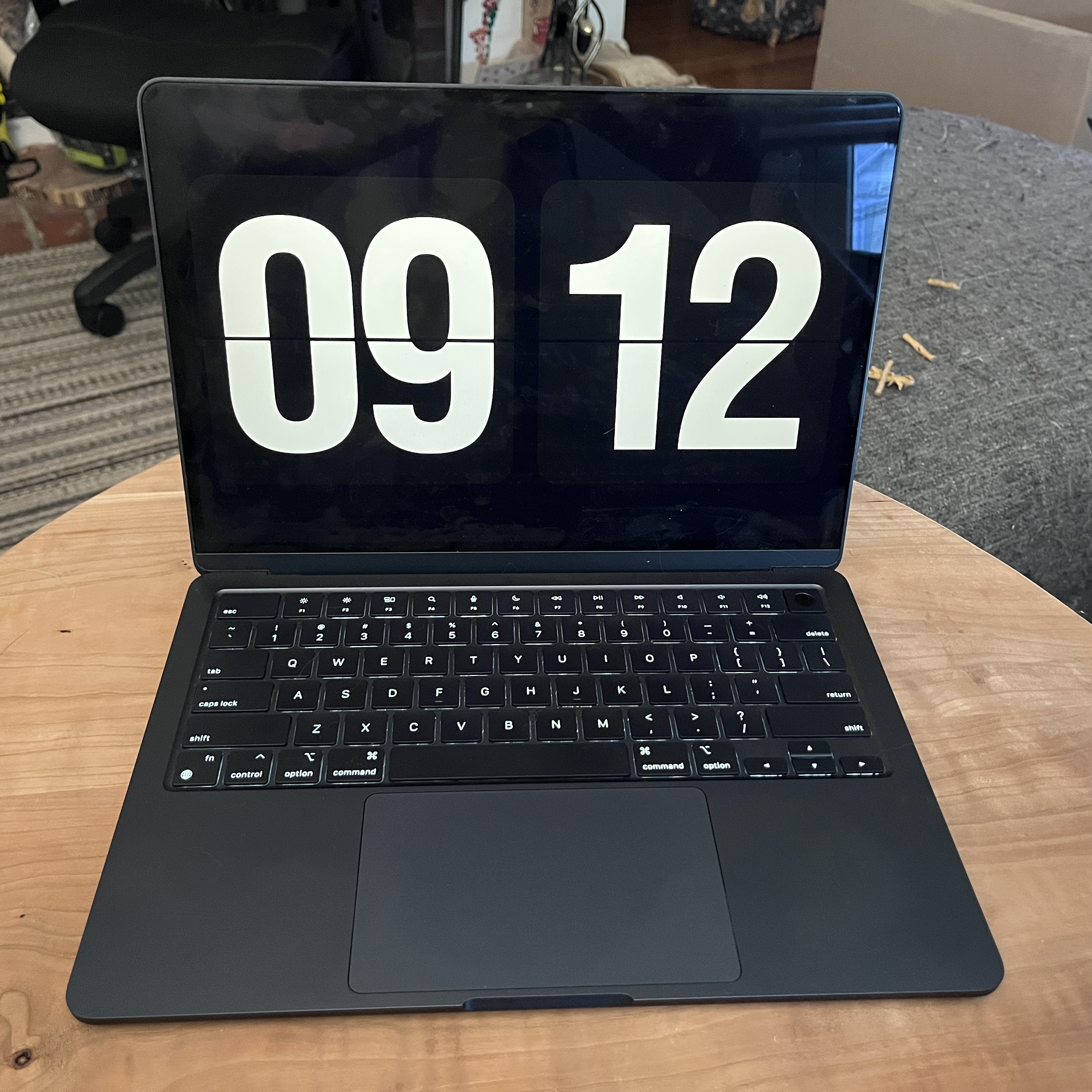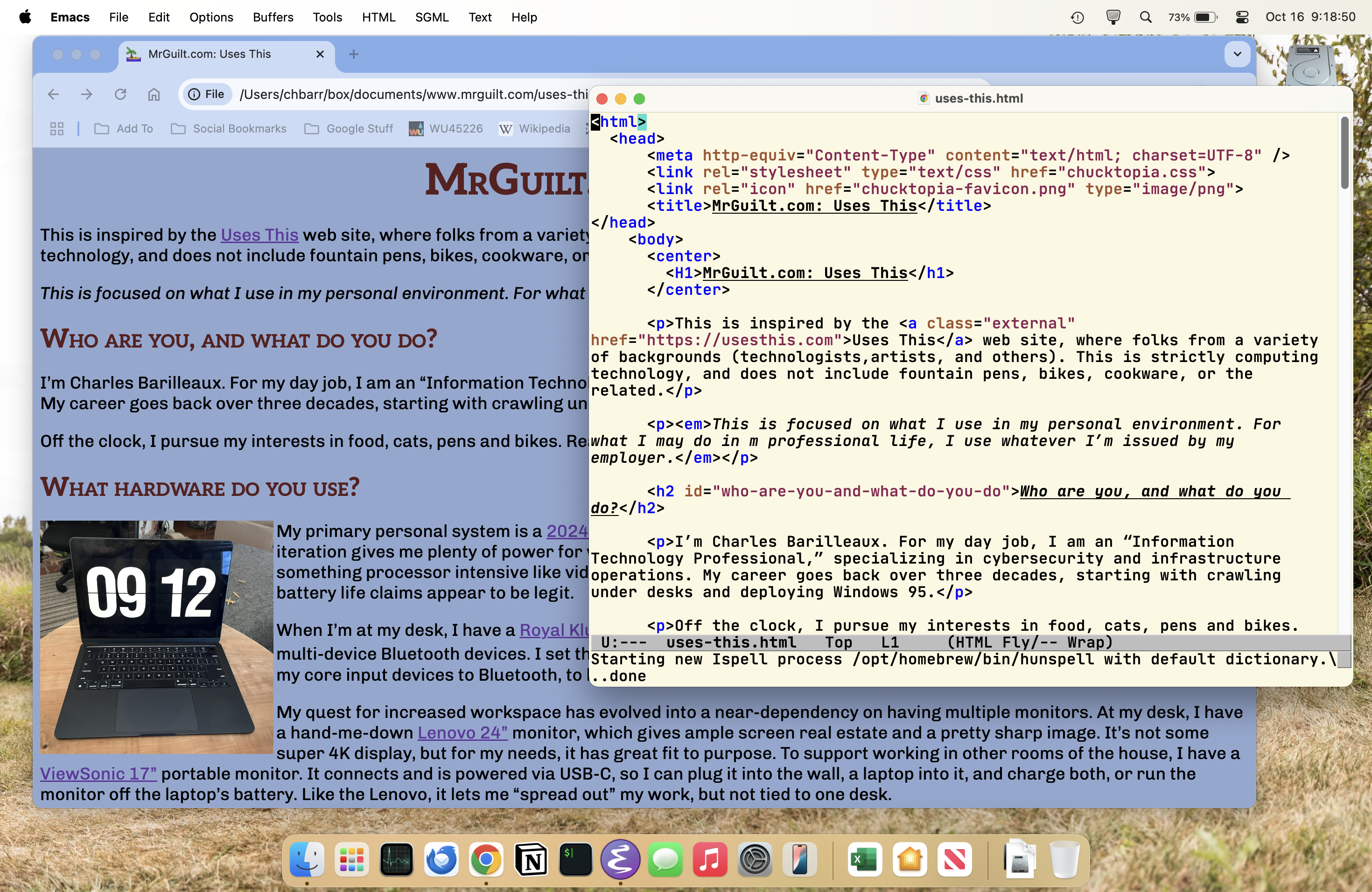(Old) Uses This
I've updated this page in 2025, but have a blog post that references this edition. I'm keeping this version up so it can be referred back to.
This is inspired by the Uses This web site, where folks from a variety of backgrounds (technologists,artists, and others). This is strictly computing technology, and does not include fountain pens, bikes, cookware, or the related.
This is focused on what I use in my personal environment. For what I may do in m professional life, I use whatever I’m issued by my employer.
Who are you, and what do you do?
I’m Charles Barilleaux. For my day job, I am an “Information Technology Professional,” specializing in cybersecurity and infrastructure operations. My career goes back over three decades, starting with crawling under desks and deploying Windows 95.
Off the clock, I pursue my interests in food, cats, pens and bikes. Really, my job just goes to support these passions.
What hardware do you use?
 My primary personal system is a 2024 MacBook Air M3, in midnight blue. I love the Mac platform, and this current iteration gives me plenty of power for what I need (great for day-to-day, and doesn’t get bogged down too badly on something processor intensive like video editing). It has amazing battery life! While I haven’t truly pressed it, the battery life claims appear to be legit.
My primary personal system is a 2024 MacBook Air M3, in midnight blue. I love the Mac platform, and this current iteration gives me plenty of power for what I need (great for day-to-day, and doesn’t get bogged down too badly on something processor intensive like video editing). It has amazing battery life! While I haven’t truly pressed it, the battery life claims appear to be legit.
When I’m at my desk, I have a Royal Kludge RK84 mechanical keyboard, and a Logitech MX Ergo trackball. These are multi-device Bluetooth devices. I set them to connect to both the MacBook and my WorkTop1. I’ve been trying to move my core input devices to Bluetooth, to live a dongle-free life.
My quest for increased workspace has evolved into a near-dependency on having multiple monitors. At my desk, I have a hand-me-down Lenovo 24” monitor, which gives ample screen real estate and a pretty sharp image. It’s not some super 4K display, but for my needs, it has great fit to purpose. To support working in other rooms of the house, I have a ViewSonic 17” portable monitor. It connects and is powered via USB-C, so I can plug it into the wall, a laptop into it, and charge both, or run the monitor off the laptop’s battery. Like the Lenovo, it lets me “spread out” my work, but not tied to one desk.
They keyboard, mouse, and monitors get used with both my MacBook and WorkTop.
I have an ongoing effort to turn paper into bits. An Epson ES-200 scanner has proven to be a great tool for this endeavor. It stores easily, and can be toted throughout the house. It can scan both sides quickly enough to turn an A5 journal into images in 10-15 minutes.
Aside from that, I have a variety of Raspberry Pis and cloud servers serving a variety of functions, ranging from web or mail servers or remote, text-only “workstations.”
And what software?
 My main OS is, of course MacOS. I’m going to go ahead and say it: it’s the only really viable desktop UNIX. It has broad support for hardware with out too much fuss. I can get out at a real UNIX prompt, but, when I just need to get something done, I don’t have to Google some esoteric work-around, or dual-boot to a different OS to run a mainstream application (I’m looking at you, Linux).
My main OS is, of course MacOS. I’m going to go ahead and say it: it’s the only really viable desktop UNIX. It has broad support for hardware with out too much fuss. I can get out at a real UNIX prompt, but, when I just need to get something done, I don’t have to Google some esoteric work-around, or dual-boot to a different OS to run a mainstream application (I’m looking at you, Linux).
I have not particular affinity for any particular email client or browser. I use Thunderbird, which I hate less than Outlook and Apple Mail/Calendar, and Google Chrome because that seems to be the de facto standard right now. My inherent dissatisfaction means I’m often trying something different, and potentially this is out-of-date.
My main tool for writing and coding is combination of EMACS, Pandoc, and Markdown. I have a lot of modules and customization for EMACS, and I can use it from a GUI or SSHed into a remote system. I’ll use Markdown to apply formatting. Pandoc will convert it to HTML or docx. Those files may get further editing in other tools.
I do a lot of my graphics creation in Inkscape. I've played with a lot of different tools like this, but, over the past year or so, I've been focusing on learning this in the interest of depth.
To engage with the rest of the world, I use Microsoft Office. You have to have Word and PowerPoint to interact with the rest of the world. In my opinion, converting from alternatives never quite work, though in isolation there are a lot of perfectly fine options. That said, nothing does spreadsheets like Excel–I actively like it.
What would be your dream setup?
Hardware-wise, I’m quite happy at the moment. One day, my MacBook will seem big and heavy and slow. But, until that happens, many years from now, I don’t feel the need for that particular change.
In terms of software, I think society is missing an application. Word processors, like Word, were designed to produce printed documents–books, term papers, and the like. A lot of functions are geared towards that, and are now either somewhat vestigial, or, due to a print-first mentality, not what they could be. But a lot of office skew more paperless, with everyone looking at the screen of a laptop, tablet, or phone. This metaphor is no longer apt. I think this is why PowerPoints get so dense–it “feels” like a better match.
I think there is a class of software that could convey information in a digital-first fashion. It would forgo setting margins, provide a better interface to help navigate a document, and allow the output to morph from a detailed document to slides that can act as effective visual aids with ease. These would also be designed with collaboration in mind and easily enable some data to be live (calculations, database connections, etc.). I’m intrigued by newer apps, such as Notion, that seem to take a more digital-native approach.
Return to the Main Page
|
Updated on September 16, 2025
|

|
 My primary personal system is a 2024 MacBook Air M3, in midnight blue. I love the Mac platform, and this current iteration gives me plenty of power for what I need (great for day-to-day, and doesn’t get bogged down too badly on something processor intensive like video editing). It has amazing battery life! While I haven’t truly pressed it, the battery life claims appear to be legit.
My primary personal system is a 2024 MacBook Air M3, in midnight blue. I love the Mac platform, and this current iteration gives me plenty of power for what I need (great for day-to-day, and doesn’t get bogged down too badly on something processor intensive like video editing). It has amazing battery life! While I haven’t truly pressed it, the battery life claims appear to be legit.